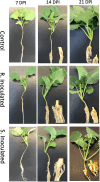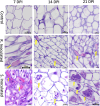Corrigendum: A proteome-level investigation into Plasmodiophora brassicae resistance in Brassica napus canola
- PMID: 40406715
- PMCID: PMC12095289
- DOI: 10.3389/fpls.2025.1597953
Corrigendum: A proteome-level investigation into Plasmodiophora brassicae resistance in Brassica napus canola
Abstract
[This corrects the article DOI: 10.3389/fpls.2022.860393.].
Keywords: Brassica napus; calcium binding; clubroot; plant–pathogen interaction; proteomics.
Copyright © 2025 Adhikary, Mehta, Uhrig, Rahman and Kav.
Figures



Erratum for
-
A Proteome-Level Investigation Into Plasmodiophora brassicae Resistance in Brassica napus Canola.Front Plant Sci. 2022 Mar 24;13:860393. doi: 10.3389/fpls.2022.860393. eCollection 2022. Front Plant Sci. 2022. PMID: 35401597 Free PMC article.
Publication types
LinkOut - more resources
Full Text Sources

